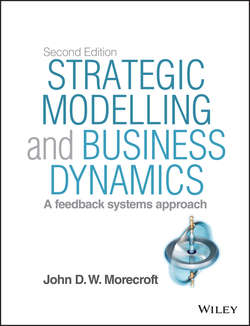Читать книгу Strategic Modelling and Business Dynamics - Morecroft John D. - Страница 13
На сайте Литреса книга снята с продажи.
Preface from the First Edition 3
Soft Systems and Complementary Modelling Methods
ОглавлениеIn November 2001, I was invited by Mike Pidd of Lancaster University Management School to join the INCISM network, and it was here, in a series of meetings that spanned two years, that I learned much more about soft systems than I had previously known. INCISM is an abbreviation for Interdisciplinary Network on Complementarity in Systems Modelling and its meetings were funded by the UK's Engineering and Physical Sciences Research Council (EPSRC). The network brought together a mix of academics and practitioners to explore the combined use of what have become known as ‘hard’ and ‘soft’ approaches to systems modelling. One result was a book entitled Systems Modelling – Theory and Practice. Through the network, the book and subsequent conversations with both Peter Checkland and Mike Pidd, I have come to better understand where system dynamics fits on the hard–soft model spectrum. It seems to me that the juxtaposition of system dynamics and soft systems methodology (SSM) reveals, in tangible terms, quite a lot about the abstract philosophy of modelling – by which I mean the different ways in which modellers interpret situations in business and society. I touch on this topic in Chapter 2 (under ‘event-oriented thinking’), in Chapter 5 (under ‘modelling for learning and soft systems’) and again in Chapter 10 (under ‘mental models, transitional objects and formal models’). INCISM also inspired a plenary session on soft systems and modelling at the 2004 International Conference of the System Dynamics Society in Oxford. Presentations by Mike Pidd and Peter Checkland described the territory covered by hard and soft modelling approaches and opened up discussion about the role of both qualitative and quantitative system dynamics. In the UK there is a long tradition of qualitative system dynamics which was started by Eric Wolstenholme and Geoff Coyle. The Oxford conference built on this tradition with its theme of collegiality as a social and scientific process to mediate between competing or complementary world views.
My interest in complementary modelling methods was further reinforced through collaboration with the Operational Research and Management Sciences group at Warwick Business School. There I found colleagues working at the interface of operational research and strategy. We had much in common. The use of complementary models and frameworks for strategic development became the focus of activity for an informal research group that included Robert Dyson, Maureen Meadows, Frances O'Brien, Abhijit Mandal and Alberto Franco (all from Warwick at the time), Jim Bryant (from Sheffield Hallam) and me.
At Warwick, I also found experts in discrete-event simulation (DES). We soon discovered a shared interest in simulation methods that transcended our differences. With Stewart Robinson, I conducted a mini-project that compared system dynamics and discrete-event models of fishery dynamics. We each built a small model of a fishery following the normal modelling conventions of our respective fields. Then we compared notes. The project led to many interesting conversations about modelling and simulation. Some of our thoughts and conclusions are reported in the appendix of Chapter 9 on alternative simulation approaches. Although both system dynamics and discrete-event simulation are commonly viewed as hard system modelling approaches, their comparison illustrates an interplay and clash of world-views worthy of a soft systems study. In a sense, this comparison was our mini-project as we built separate fishery models and then reflected how our professional backgrounds led us to interpret and represent the problem situation in fisheries. The fishery models also opened the door to the discrete-event simulation community, making possible further collaborative research with Ruth Davies, Sally Brailsford and others at the boundary of system dynamics and DES.
